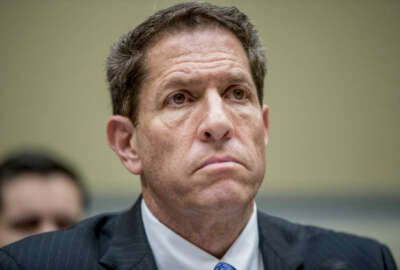Hubbard Radio Washington DC, LLC. All rights reserved. This website is not intended for users located within the European Economic Area.
A book full of new advice for federal managers who want to get things done
Federal Drive Host Tom Temin's guest is a former federal chief information officer, who served in both political and non-political appointed positions. He has ...
Federal Drive Host Tom Temin’s guest is a former federal chief information officer, who served in both political and non-political appointed positions. He has a thing or to say about government performance and delivering on programs. And he’s published a book about it. Former IRS and Homeland Security CIO Richard Spires joins the Federal Drive withTom Temin for this conversation.
Interview Transcript:
Tom Temin And you have written a pretty weighty tome here on the fact that government can deliver. And of course, that’s in contrast to some pretty spectacular failures. I think probably most in people’s mind right now is the horrible waste that is coming to light in the misspent funds from COVID relief. How much fraud? How much improper payment there was related there to. So looking at it from a positive side, what makes you write a book that says government can deliver?
Richard Spires Well, you know, it’s interesting. In my time in government and also serving government as a contractor, I saw a lot of positive things that were done in government. But I also saw some of the, let’s say, negatives. And over about two decades, I really started to see patterns in what was working in government and having also spent a lot of time in the private sector. I do believe you can bring some best practices in the private sector, but they need to be modified a bit for government. So when I left DHS about a decade ago, you know, I always thought, man, I want to really try to help government continue to perform and improve. And, you know, I got this idea that I really needed to write my ideas down. And that’s what really ended up being this book. And I’ve really tried to distill it and hopefully write maybe at tome. Hopefully it’s somewhat entertaining because I try to bring it to life through real vignettes, whether those vignettes were personal to me in dealing in government or whether they were learned vignettes from studied of other programs that did well or didn’t do well, or quite a few interactions I’ve had with colleagues and talking about what works in government, what doesn’t.
Tom Temin Yeah, and there’s a couple of anecdotes that are interesting somewhere in the middle of the book you mentioned that you did receive a cut in the budget for business systems modernization at IRS. And you felt that was almost a positive because you could narrow the scope of the program rather than having it spread too thin and nothing coming quite out correctly.
Richard Spires Yeah, in fact, I take out that word almost. I think it was a good thing we were. I hate to waste money. And in that situation I entered the IRS to take over the BSM program. And in my first few weeks there, I started to really understand that we just didn’t have the management talent. And this is a perennial problem in many agencies that management talent to oversight the number of programs and projects we had underway in modernization. So I was like, Boy, it’d be better to scale this back to a smaller number where we can really manage them effectively, show we can do this and then scale up over time as we right the ship, and if you will, bring in more and develop more management talent to oversight these programs and projects. And so it’s a real theme in the book.
Tom Temin And I would say a theme running through the book is the fact that the continuity of the standing workforce just can never be discounted. Because you talk about the fact that political appointees, even the best intentioned ones, find running a large federal bureaucracy is really difficult, and they often burn out in a couple of years. And that’s why we have this often short tenure for so many of them.
Yeah, that’s right. And I get into a decent amount of depth about comparing and contrasting political appointees. And look, I understand the system and it makes sense in that regard. But when you compare it to the private sector, like, you know, a simple stat, I mean, the average CEO of private sector corporation is in that job for seven plus years. And that rarely, rarely happens in a government agency where you have that kind of tenure and even beyond that, that CEO, where that individual come from, typically they were promoted from within and that private sector organization not right from without. And the other thing and I spent a decent amount of time at DHS where we had, you know, more than 280 political appointees, including myself at the time. But, you know, a lot of them, frankly, were ill suited for the job they were at. And that’s not against them. I mean, a lot of them were good policy. People had deep knowledge, very intelligent, capable people, but didn’t have the management experience and their background to handle the kind of management responsibilities they were given in government. Those are issues that should be dealt with. And I’m not suggesting we cut back on the number of political appointees. I think that would be a naive thing to think we would do that. But if you’re a head of an agency and you’re recruiting and bringing people in, you know, being very mindful of getting people that have real experience to handle the job you’re putting them in is would in and of itself make a significant positive difference.
Tom Temin We’re speaking with Richard Spiers, author, former IRS and Homeland Security CIO, among many other things. And what is the difficulty and or I should say, how should federal managers approach the difficulty with more deftness in the fact that programs often have political expectations and political underpinnings, and yet the standing federal civil servant workforce is there to deliver services in a totally nonpartisan way.
Richard Spires That can be a real tension at times. I spend a decent amount of time on the book, a whole chapter about good governance. Tom And really good governance drives good alignments and decision making across the agency if it’s done well. And I bring up that term alignment because too often I would find that executives, sometimes politicals and the career are kind of at cross-purposes to your point with each other, and that’s very hurtful for any organization. So you need to work to drive alignment within an agency. And by bringing people together and the right kind of governance model where you set up the right level boards, you delegate decision making in the right way. These are large organizations. Typically, even a mid-sized federal government agency is larger than most corporations. So you need to deal with this and you need to delegate and set up. I’m huge on portfolio management and governance because we don’t do enough of that in government. I mean, you have got too many things going right to the top. I saw this in DHS in spades. I mean, I was sat on the Investment Review Board. We were trying to oversight 120 major programs. I mean, you can’t do that effectively. That makes no sense. So there’s a lot there on the governance side to try to drive alignment. And I do believe and I saw it happen, that you can get alignment many times between politicals and career execs, but you got to work at it, right? It’s not going to just happen. You really need to work on it. And those politicals coming in need to respect and understand that these career executives are there for the mission. As you say, they’re not there for the politics. They’re there to deliver for the U.S. citizen. I think that needs to be respected and championed even.
Tom Temin And may maybe the best way for the overseers to handle things is to just look at the metrics and make sure those are met. Make sure that the bureaucracy is performing in a way to give out those metrics. But the question then becomes, what are the right metrics? Again, to get back to the issue of the waste and abuse that happened in all of these pandemic relief programs, the extent of which is still coming to light. The metric was, well, let’s get the money out there fast. And maybe a different metric. You get what you measure, basically.
Richard Spires Yeah, I have a chapter in the book around operations, and one of the attributes for good operations is to define a comprehensive set of metrics that are appropriate for whatever the operation may be. To your point, I mean, it’s rarely one metric, and it’s usually going to be a collection of a few key metrics in order to be able to understand what’s really going on in an operation. And I talk a lot about then using those metrics and really improving your operations. I think that’s another thing that I’d like to see government agencies do a lot more of is really work to make both incremental improvements Lean Six Sigma, things like that drive the waste out of operations, but then also reimagine things. I mean, with today’s digital technologies. I mean, you talk about digital transformation. It may be an overused term, but it’s still an appropriate one where we really kind of reimagine what you can do today. And too many agencies for cultural reasons, mainly, in my view, they’re not aggressive enough and really looking at their operations and how do they improve.
Tom Temin And a final question on the workforce. You devote a lot of writing to the workforce issue. That seems like the most important thing really for career managers to deal with, is workforce planning, which, you know, is not really been a strong suit for the government.
Richard Spires Yeah, good point. In fact, I talk about eight solution functions to address, you know, getting agencies to be more effective and efficient. And the very first one is the employees, the workforce. And to your point, one of the things in the model that I espouse, you really for key positions across the agency and this isn’t just the top managers. I mean, it can be at all levels. You really do need to define what we call the knowledge, skills and abilities, the KSAs the courses that go with the position and develop learning paths and develop, if you will, career paths for individuals to effectively be able to fill key roles within an agency on the career side. And again, to your point, I just don’t see it changing much. I’ve been involved closely with government for 20 plus years, and I hate to say it, but it doesn’t look like we’ve made much progress in this particular area of human capital development across the government.
Tom Temin Well, maybe people will read your book and get after it. Richard Spires is former IRS and Homeland Security CIO, consultant, technologist and author of “Government Can Deliver.”
Copyright © 2024 Federal News Network. All rights reserved. This website is not intended for users located within the European Economic Area.
Tom Temin
Tom Temin is host of the Federal Drive and has been providing insight on federal technology and management issues for more than 30 years.
Follow @tteminWFED





